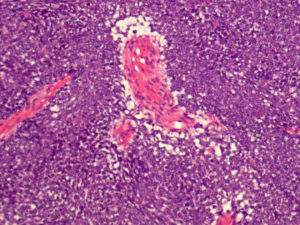Wilms tumor and aneuploidy
Wilms’ tumor or nephroblastoma is an embryological tumor of infancy that belongs to the category of “small round blue cell tumors” (Fig. 1). Such tumors are characterized by an accentuated basophilia of the nuclei with a notable increase of nucleus to cytoplasm ratio and very little and no discernible cytoplasm. Recently, genome-wide sequencing and analyzed mRNA and miRNA expression, DNA copy number, and DNA methylation in Wilms’ tumor identified genetic alterations inBCOR(BCL6 Corepressor),BCORL1(BCL6 Corepressor Like 1),NONO(Non-POU Domain Containing Octamer Binding),MAX(MYC Associated Factor X),COL6A3(Collagen Type VI Alpha 3 Chain),ASXL1(ASXL Transcriptional Regulator 1),MAP3K4(Mitogen-Activated Protein Kinase 4), andARID1A(AT-Rich Interaction Domain 1A) genes in addition to long time known genetic alterations ofWT1(WT1 Transcription Factor),CTNNB1(Catenin Beta 1),AMER1(APC Membrane Recruitment Protein 1),DROSHA(Drosha Ribonuclease III),DGCR8(Microprocessor Complex Subunit),XPO5(Exportin 5),DICER1(核糖核酸酶III),SIX1(SIX Homeobox 1),SIX2(SIX Homeobox 2),MLLT1(Myeloid/Lymphoid Or Mixed-Lineage Leukemia; Translocated To, 1 Super Elongation Complex Subunit),MYCN(Proto-Oncogene),BHLH(Transcription Factor), andTP53gene. TP53, also known as p53, is a gene which acts as suppressor in many tumor types.

Fig. 1. The microphotograph shows a hematoxylin and eosin stained slide taken at x100 as original magnification of a blastema component of a triphasic nephroblastoma or Wilms tumor. The tumor cells exhibit a pronounced basophilia and a high nucelus to cytoplasm ratio.
Moreover, the protein encoded by this gene contains domains of transcriptional activation, DNA binding, and oligomerization. TP53 responds to diverse cellular stresses to regulate expression of target genes, in that way inducing cell cycle arrest, programmed cell death (apoptosis), senescence, DNA repair, or changes in cellular metabolism. The use of alternative promoters and alternative splicing of this gene result in multiple transcript variants and isoforms. It has been demonstrated that integrated analyses support two significant classes of genetic changes that preserve the progenitor state of the tumor cells and/or interrupt healthy development. Euploidy means the healthy status of the chromosomal set (46, XY or 46, XX). Aneuploidy refers as to an abnormal status of the chromosomal set, such as triploidy harboring three times the haploid set (3x 23 equals 69 chromosomes) and trisomy 21 having an extra-chromosome 21 (47, XY,+21 or 47, XX,+21). There is a crucial difference between constitutional and acquired aneuploidy. In constitutional aneuploidy, the ploidy status is changed in many tissues from the earliest stage of embryonic development with some variants including mosaic in which only some tissues have an abnormal status. In acquired aneuploidy, the abnormal status exists only in the transformed cells. Subsequently, constitutional aneuploidy can predispose to cancer in many fashions. Constitutional aneuploidy can exert a direct oncogenic activity in a cell-autonomous manner.
This situation occurs in cancers in which the same aneuploidy is also common in sporadic cancers such as trisomy 21 (three times of chromosome 21) in acute leukoblastic leukemia, trisomy 8 (three times of chromosome 8) in myeloid leukemias, and trisomy 18 (three times of chromosome 18) in Wilms’ tumors. Alternatively, cancer may arise because of aberrant effects of the trisomy on immediate microenvironment, disorders of the sex chromosomes, hormonal replacement therapy, susceptibility of abnormally developed organs to carcinogenesis (e.g. altered immunosurveillance). An increase of the incidence of tumors has been observed in (I) specific disorders: aniridia, hemihypertrophy, and basal cell nevus syndromes among others; (II) cytogenetic abnormalities (e.g., trisomy 18 syndrome); as well as (III) chromosomal instability syndromes, including Fanconi anemia, ataxia-telangiectasia, and Bloom syndrome.
Consolato Sergi
Department of Lab. Medicine and Pathology, University of Alberta, Edmonton, AB, Canada
Publication
Bilateral Wilms’Tumor in Trisomy 18 Syndrome: Case Report and Critical Review of the Literature.
Sergi C, Kos M
Ann Clin Lab Sci. 2018 May













Leave a Reply
You must belogged into post a comment.